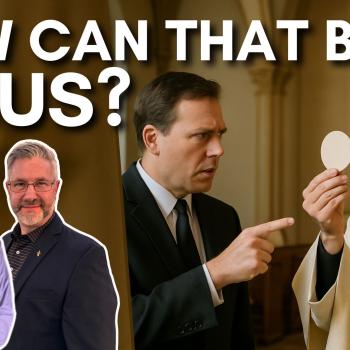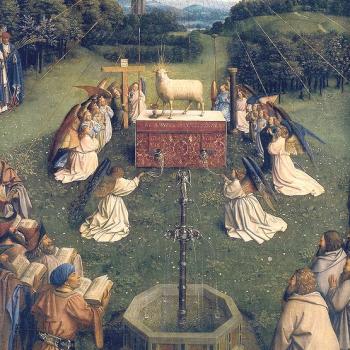If the choice is between the EF [extraordinary form of the Roman / Latin Rite or the Tridentine Mass] and how the OF [ordinary form or Novus Ordo or “New” Mass in the Roman / Latin Rite] is ordinarily celebrated (no pun intended), no contest.
If the Mass wasn’t celebrated in the virtually unique way it is in my parish (very “traditional” OF), almost certainly I’d be attending the EF because the outward, aesthetic way in which the OF is so often celebrated “feels deficient” to me: too often, lousy music (both the music used and the performance), inane architecture; loss of a sense of the Real Presence, extreme overuse of eucharistic ministers, the loss of the bells and incense; the whole nine yards.
Note that I am entirely centering on abuses or ancillary mediocrity: not the essence of the OF itself. The OF Mass at my parish has retained traditional elements of the Mass in those “mythological” or symbolic respects, which I would say is a good thing, because I’m fundamentally “traditional” in that sense and many others. Unfortunately, the OF often omits “smells and bells” and other “fuller” elements, so when it retains them, we can talk of maintenance of traditional liturgical practices, which are mostly (in practice) preserved in the EF within the Roman Rite.
I don’t think in essence it has to be the case, because the OF can (and sometimes does) preserve “smells and bells” and other traditional elements of the Mass. Vatican II intended for any Mass reform to do that (including Latin), but alas, it was not to be, for the most part. To actually follow through on the original post: I think that architecture, statuary (or icons), stained glass and other ecclesiastical art and music, are also key to fostering the “Catholic imagination” and worldview, in addition to the form of liturgy.
This is what I also love about my own parish: all of that is impeccable (German Gothic Revival style, with lots of lovely woodwork). We have some of the best stained glass in the country: also one of the largest bells in North America. Let’s be sure, however, to distinguish two different issues:
1) Should we be happy and content where we are; be committed to our parish and friends there, and realize and be thankful that we receive Jesus in the Mass [yes].
2) Ideally, should we have the “fullness” of the beauty and tradition of Catholic liturgy and art at Mass [yes].
It’s not about what we “get out of” Mass, but what God gets out of us; and he gets more out of us, I submit, if the worship experience is as full as it can be, incorporating all of our senses and deepest aspirations, and appealing to the whole person in as many respects as possible. If I were to compare my worship at Mass now, to my worship as an evangelical, meeting in a bare YMCA hall, there’s no contest whatsoever.
Even pagans and atheists are almost invariably moved by, and recognize the profundity of a beautiful cathedral or basilica. My evangelical worship was altogether wholehearted and sincere, too, and a good thing, but compared to a Gothic Cathedral? Beauty was always intended to be part of worship, as we see in God’s elaborate decorations in the temple. We don’t (or shouldn’t) conclude that we ought to build no beautiful churches because others are aesthetically mediocre or even outright bad architecture, and/or including bad ecclesiastical art.
There is scarcely any argument that could be made against what I’m staking out here (I submit). In effect, oftentimes people will assert, “if these elements of art and beauty and liturgical fullness that I myself acknowledge are good things, are not present, I will still be content in my worship and recognize that I receive Jesus.” Yes; we all agree. If anyone didn’t agree, I would give them a hard time! But if the question is, “is it better to have more of these elements of beauty and ‘high liturgy’ than to not have them?” — I say it’s clearly preferable to have them.
Virtually no one would deny the “goodness” of a beautiful cathedral (though, sadly, many seem to disparage the EF or a traditional OF, such as what I attend). They simply do an “end run” around that and say, “that’s all cool; lovely stuff, but we don’t have it at my parish and I’m a content and happy Catholic anyway.” They “settle” for less. And perhaps that gets to the heart of what I’m driving at.
Contentment (Phil 4:11) and non-complaining (Phil 2:14) are proper (and required / commanded) attitudes for any Catholic to have. The interior disposition or “attitude of the heart” is supremely important and is what it is all about in the end (see the Sermon on the Mount). But I’m contending that the Church should foster a fuller worship that incorporates these other elements, so that it would be unnecessary to have to have an attitude of, “our parish is great despite [deficient visual and liturgical aspects] a, b, c, …..z”
Nothing is perfect, of course, but I don’t think these things should have ever become issues at all. Once upon a time, a Catholic church was beautiful, period. That was a given. There was hardly an instance of one that wasn’t. So for that not to be the case today is clearly a net loss. I don’t see how that is even arguable, unless someone makes a positive case for modern “art” or minimalism or whatever one might call it (yuk!): that a gymnasium-type sanctuary is preferable to traditional Catholic architecture.
Just from a completely neutral, common sense, practical perspective: why “get rid of” something that is perfectly acceptable (not to mention, beautiful), that’s already there? It’s just stupid: dumb economically and every other way. I think the mentality of these notorious “church rapings” wasn’t just so-called “progressive” or supposedly the “spirit of Vatican II.” It was the spirit of modernism in its worst sense and of sheer anti-traditionalism. These guys didn’t get it. I fully agree with “traditionalists” that these things are supremely important and can’t be separated from the whole of Catholic worship.
To tear down beautiful altars or other beautiful items in a church is to make a statement about theology or worldview, and of liturgy. And it’s not a very good statement . . . The “simplicity” fetish was simply repeating the errors of the so-called “Reformation.” The early Protestants (i.e., Calvinists, Anabaptists mostly) wanted to get rid of what they considered “unnecessary extras” at best and idolatry at worst. Thus, we have to ask ourselves why a Catholic would think in the same way, unless he had, in fact, adopted tenets of modernism that are fundamentally un-Catholic and more in accord with iconoclastic and relatively less sacramental strains of Protestantism.
I think this is why many “traditionalists” argue (falsely, in my opinion) that the Novus Ordo was “Protestantized” — because they saw what was happening in association with it: the raping of beautiful churches. Since the latter suggests what I have been saying: modernism and anti-traditionalism, it was guilt-by-association and they concluded that the OF Mass itself must be a product of the same unsavory forces of liberal theology and heterodoxy among Catholics.
Even Luther didn’t get rid of beauty and severely chided his former colleague Carlstadt for his iconoclasm. On the other hand he winked at and rationalized (like his fellows in England) the wholesale stealing of churches by the multiple thousands, so he was a bit double-minded.
Catholic writer Simcha Fisher wrote an article entitled, “Why I Love My Ugly Little Liturgy” (National Catholic Register, 21 Feb. 2011). She’s making the same argument that I noted above, and helps prove my point. It’s not an argument against beauty, but for humility (something different from beauty: another topic altogether) and “settling”. One thing doesn’t cancel out the other. It ain’t a zero-sum game. She’s arguing as St. Paul did: being “content” and not a grumbler in all situations.
I ask, though: why should we have to settle for mediocrity and “ugly”; why should it be an issue at all, that we have to be in a position at all to have to joyously accept (almost as a penance) a shoddily performed liturgy or ugly church building? We have accepted it as the status quo, far too often. She’s settling for that and making the best of it. I think what I’m saying, is that we have to do a deeper analysis than that (I’m always examining premises, as a good socratic): we shouldn’t settle for what pretty much everyone (even the ones who try to defend it in the above sense) agrees is mediocrity or lacking important aesthetic elements.
Instead, we should ask why this is, and how we can get back to the more universal beauty in church settings that used to be a given and not something we now have to take pains to seek out. It took one visit to my present beautiful church to convince me it was the place for me. Now, Protestant friends of mine, and some Catholics, would say I was merely attracted by smells and bells and lovely windows, etc. It’s not “merely” and it’s not just the beauty that attracted me (though it is valid on that level, abstractly considered in isolation, and I do love those things).
No; it was the fact that this was not only objective (quite majestic and breathtaking) beauty: good aesthetics, but also architectural and liturgical tradition, which means something highly important. Tradition is good; continuity is good. Christianity presupposes that in notions like apostolic succession and development of doctrine and councils and popes building upon the thoughts of previous ones. We can’t fundamentally alter what came before, and that is true in architecture (I would argue) as well as in liturgy: though the former is far more subjective and falls under the huge, complex discussion of the nature of beauty.
Beautiful architecture in a church, and beautiful liturgy ring true. It’s almost like it goes beyond all rational argument. One either intuitively grasps and “gets” this or they don’t. But even the ones who don’t seem to get it or do, but place it far lower in the scheme of things in importance, don’t argue against a beautiful, traditional church so much as they argue in favor of “settling” for ugliness and mediocrity. I think that’s ultimately putting the trees before the forest: looking at a molecule in a piece of bark on one tree, rather than the beauty and totality of the whole forest.
I have written in the past, defending expensive church buildings (a similar topic). People argued against me, saying it was a waste of money, etc. I retorted that until our society stops making expensive “temples” to mere materialism / commercialism or art for its own sake, we need not stop building a beautiful building for God, since the latter is more meaningful than the former, by far. And we have the model of the temple: God’s own instructions, in that case. It’d be one thing if society didn’t spend gazillions of dollars for basically our own pleasure and amusement, or on our own houses, yachts, etc.
But it does that and then tells Christians that they ought not build beautiful (expensive) worship buildings for God, and that this detracts from helping the poor. That makes no sense. If absolute poverty is the goal, then folks can do that if they wish. But they shouldn’t accept all sorts of materialistic buildings and art, yet deny it to the Church. The double standard and hypocrisy is what I never stand for: “I can do this, but you (or the Church) must do something different.”
The article from Simcha Fisher, mentioned and linked above, doesn’t touch the argument for beauty that I am making. One thing is about humility and avoiding pride and the other is about aesthetics and the relationship of beauty to worship and reverence. All things can be distorted. Beauty for its own sake is an idol. Beauty for the sake of glorifying and worshiping God is standard-issue Catholicism (or was till the last 50 years).
I don’t go to my church building to worship the stained glass or gaze at them with rapt admiration the whole time. I worship God through them and fill up my senses. I think this is the worship experience as the Catholic Church has conceived it throughout most of her history. The beauty was part and parcel of it. No one thought to separate beauty from the Mass till this notion that “simpler is inherently better” came in, which is a modernist / Protestant (almost iconoclastic) conception at heart.
Speaking for myself, if I have the choice, I’m gonna pick the more beautiful church almost every time, because to me that is an important element in worship (and the Church agrees, which is why she constructed mostly beautiful, awe-inspiring churches, lo these past 2000 years). Having done that, I’m loyal to my parish. I’ve been there 22 1/2 years: my entire time as a Catholic except for the first five months. I don’t think Catholics ought to be put in positions where we feel we have to “settle” for mediocrity, or to “make the best of it.”
Our churches and liturgies should be beautiful and reverent, period, and if they aren’t, we should vote with our feet and go to parishes where that is the case. Enough is enough! The others will wake up amazingly quickly, if they see their revenues decreasing. But of course, the problem is that it looks like not enough people feel this way for there to be a major change in the status quo. Like bad catechesis, these sorts of things aren’t talked about much (far less than even doctrine and theology are talked about).
It has to spread almost by word of mouth, blogs, Facebook, etc. We should never settle for “ecclesiastical junk” that we know ain’t how it ought to be. Why would anyone take a position: “Scenario A [beauty in the church and liturgy] is far superior, but in most cases it is Scenario B [pervasive ugly stuff]; this being the case, we happily accept B in abject submission and docility and make the best of it and learn spiritual lessons of patience and perseverance, etc., because Jesus is there.”
I don’t get that. That seems to presuppose that we are all dumb little sheep that will blend in with whatever is around us, and never make intelligent criticisms of it. But the Catholic is not bound to attend any particular parish. Thus, he or she has a choice (sort of like with schools: unless one is poor and can’t homeschool and lives in a liberal-dominated area; thus is forced to send their children to mediocre schools).
When we learn in the Bible the sort of building that God wants, for us to best worship Him, it’s the temple: an extravagant, elegantly beautiful building that incorporated all five senses. Everything in a traditional Catholic Mass is explicitly biblical (I’ve documented this in my book, Bible Proofs for Catholic Truths): incense, candles, repeated formal prayer, the Tabernacle front and center, statuary, bowing and genuflecting: everything. Simcha Fisher, I would note, is not arguing for a permanent “settling for mediocrity” in her article. She states:
It’s good for us, every once in a while, to attend a liturgy that we think isn’t good enough. . . . A little ugliness is good for us, folks. Taken in the proper doses in the right context, a little bad taste is something we need, . . .
I agree, but I disagree with her when she writes: “too much beauty can have a coarsening effect.” People can always fall into various errors of excess or limitation. But the fault lies not in the beauty itself: it’s in the person’s relationship to that beauty, in relation to other elements. God won’t appear and sweep away all the ugly churches with a breath of His nostril.
We laypeople have a place in all this! We’re not automatons. We can speak up and decry ugliness, so it doesn’t have to be that way. We don’t have to accept it. And we can “vote with our feet,” if needs be. But she does (thank heavens) qualify it and isn’t saying we should stay in such a parish, so the article is completely acceptable in that way, and in its advice on what to do if we are in such a parish for a day or a few weeks. Nor is she contending against beauty.













